Self massage for high blood pressure
Clinical trials have shown that massage is effective in relieving fibromyalgia. However, the results show that some are better than... Read Article
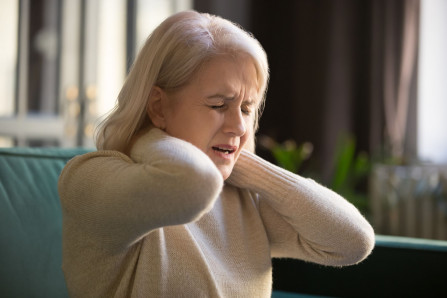
Clinical trials have shown that massage is effective in relieving fibromyalgia. However, the results show that some are better than others, and there are are some definite guidelines for getting decent results.
In this article we will go over:
As the summary table below shows massage has given excellent relief for fibromyalgia in many clinical trials. This is because pain from your muscles (mainly (myofascial) trigger points) contributes very heavily to fibromyalgia pain, and massage is an excellent therapy for this pain. How does muscular pain contribute to fibromyalgia?
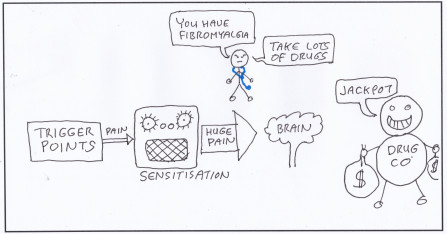
Doctors will tell you that the cause of fibromyalgia is unknown, but scientists have found that the main cause is having pain bombarding your nervous system for a long time (1-9). This causes your nervous system to become sensitised. When your nervous system is sensitised it acts like an amplifier, making pain feel much worse. Also, because the nervous system is the master control system of the body it can cause may seemingly unrelated symptoms.
The good news is that scientists have found that if you remove the pain that is causing the sensitisation the fibromyalgia symptoms settle down, For more information: The root cause of fibromyalgia
Trigger points are arguably the biggest cause of musculoskeletal pain such as back, neck and shoulder pain. This pain can add to your fibromyalgia symptoms. For more information The root cause of fibromyalgia
In the section below we cover detailed guidelines, "how to" and a summary of the research, but before that you might like to check out our quick summary video.
Most styles of massage improved fibromyalgia, but from the results of the trials and our our clinical experience we give the following advice.
While general muscle tightness and soreness is an issue research shows that the main problem is the trigger points. Therefore the therapies that target trigger points gave better results than more general massages. We will discuss these therapies in our next section guidelines for the best results
Sensitisation makes any pain feel much worse, so painful techniques may not be tolerated and just make the condition worse. One trial used friction techniques which are painful and clearly a poor choice, but pressure techniques can also be very painful.
The clinical trial results and our clinical experience show that you will need a large number of sessions of massage over time. A lot of the trials used from 10-20 sessions, but only gave partial relief. Also, in one trial where the massages were stopped after 15 sessions the fibromyalgia symptoms gradually returned over 6 months. If all those massages were done by professionals it would be prohibitively expensive, however below we give you self massage options that are at least as effective as professional therapies.
As the clinical trial results show it is certainly possible to use massage to successfully treat fibromyalgia.
Fibromyalgia is a difficult condition to treat. Although you may do a lot of the massage therapy yourself you should seek the advice and support of a professional qualified in dealing with these muscular issues, such as a Chiropractor, Osteopath or a Physiotherapist. Musculoskeletal conditions can be complex needing additional care, and they can help keep you safe. He or she will be also be able to advise on a lot of issues such as where to massage and how often.
The main issues in your choice of massage are:
In the section below we show you several excellent self massage options you can use. If you wish to use at least some professional therapy options the appendix below gives a summary of each.
Please be advised by your professional. However, the following is a guide.
Because of the sensitisation your body will be less tolerant, so start off very conservatively, then gradually increase the intensity as you improve. The massage should generally be relaxing your muscles and increasing their blood flow. You should not be feeling sore after a massage.
All the trials used a large number of massages (and still gave incomplete relief). Rather than trying to accomplish too much at once you are far better off having multiple less intense massages, letting your body recover and adapt in between.
Because of the sensitivity it is possible to have a flare up of symptoms after a massage. Discuss this with your professional, but generally the advice is to let it settle down then continue a bit more conservatively.
All of the trials only produces incomplete relief, and as one trial found if you discontinue the fibromyalgia symptoms gradually come back. As long as you are gradually improving definitely keep going. If you become completely symptom free or reach a plateau keep going with some sort of maintenance routine.
Treating fibromyalgia can sometimes be tough and discouraging. To help you through this please check out the results of the trials below showing that it can work.
Trial |
Type of massage |
Duration, frequency, number |
Outcome |
|---|---|---|---|
Friction massage vs stretching vs analgesics |
Uncertain |
Friction massage not beneficial. Friction massage is a painful massage not suited for trigger points |
|
Compared Swedish massage with TENS machine |
Ten 30 minute sessions @ 2 per week |
Massage resulted in less pain, less fatigue, better sleep and lower anxiety |
|
Connective tissue massage |
15 sessions @ 1.5 per week |
Massage gives pain relief, relieved anxiety and improved quality of life. After treatments finished improvements gradually diminished over 6 months |
|
Swedish massage compared with standard physician care |
Ten sessions over 24 weeks |
Massage showed improvement, but only small numbers in trial |
|
Combination of styles |
30 minutes, twice a week for 5 weeks |
Less, pain, less anxiety and better sleep |
|
Myofascial release massage |
Weekly 90 minute session for 20 weeks |
Improved pain and quality of life |
|
Myofascial release |
Ten 60 minute sessions over 20 weeks |
Less tender spots, improved physical function |
|
Swedish massage vs myofascial release |
90 minute session weekly for 4 weeks |
Both produced pain reduction and improved movement. Myofascial release had better results |
|
Full body Shiatsu |
Sixteen 40 minute sessions @ twice a week |
Improved pain, tenderness and sleep |
|
Mechanical massage device called Cellu M6 |
Fifteen weekly 35 minute sessions |
Improved pain and function, and reduced number of trigger points |
Because of the large number of application needed most will use at least some self therapy. In this section we will give you some excellent self massage techniques that emphasise trigger points.
How to find your trigger points
Manual massage and "pressure points"
Vibration massage (best option)
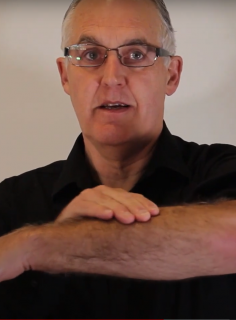
Trigger points are tender lumps within tight bands of muscle. When you press on them they will shoot pain and sometimes cause the muscle to twitch. We thoroughly recommend that you consult a professional who deals with trigger points to help identify the ones affecting you and show you how to find them, but we share with you the basic examination procedure. These are demonstrated in our video on treating forearm muscles
Gently press on the muscle with flat fingers, examining for areas of general tightness and tenderness. When found, use one or two fingers to explore more deeply for tightness and a tender lump.
Manual massage techniques performed by professional therapist can be an effective trigger point therapy. There are home techniques that mimic these. As we discuss in our article Do foam rollers work we have reservations about the use of tools such as balls and foam rollers to apply painful pressure, but will show you two relatively safe and effective techniques.
One of main massage techniques is called “stripping” (technical name= effleurage). Think of gradually moving along the muscle like squeezing out an old sponge. To do this lubricate your skin, apply moderate pressure and move along the muscle slowly. As the veins and lymphatic vessels have one way valves this needs to be done towards your heart.
To turn this stripping technique into a very effective trigger point therapy, when you get to a tight spot or trigger point stop and hold the pressure for 5-10 seconds, then slowly move on. The safest and best way to do this technique is to start with light to moderate pressure then gradually repeat with more pressure. For a demonstration of this please see our video on treating forearm muscles
Professional therapists use various techniques that apply pressure direct to the trigger point. There are a lot of people advising to do this at home with balls and rollers. As discussed though we have reservations about the risks and benefits of doing this. In clinic we have seen seen way to many patients hurt themselves and get very little benefit. However, there is a very safe and effective way to use pressure techniques at home. In a trial of a traditional Thai home massage (24) a special tool with a long handle was used to apply moderate pressure to relaxed muscles. Each day each trigger point was given five applications of this moderate pressure for five seconds each. This tells us painful pressure is not needed. Multiple applications of moderate safe pressure work very well.
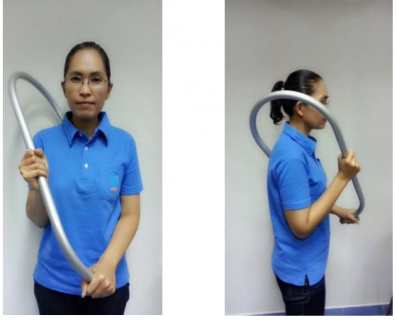
Safe and effective Thai technique
Using the tool allowed the muscles treated to be relaxed. 5 seconds of moderate pressure pressure was applied five times. This was repeated each day. To use this technique find each trigger point, make sure the muscle is relaxed, then use either your hands or some sort of tool to give multiple applications of moderate pressure.
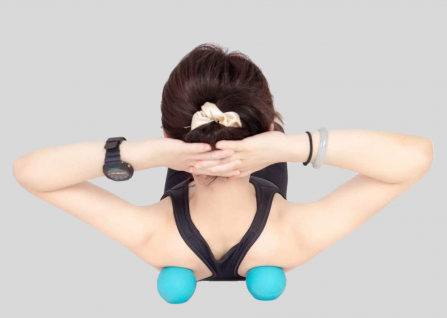
Ball and roller techniques
For comparison this picture shows applying pressure to the same muscles using a ball. Note that the muscles are far from relaxed, and being an awkward position it would be far harder to control the pressure.
Vibration massage is widely used by professionals to treat trigger points. It is done by simply placing the vibration massager over the trigger point allowing the vibrations to penetrate and have their effect. Because it does not require penetrating pressure it is relatively safe, and because no special skills are required it is far easier to self apply.
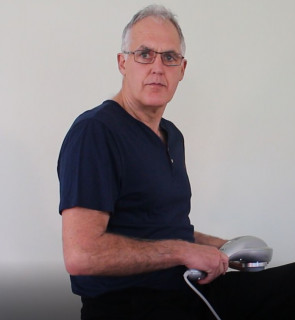
Manual therapies rely on skilled application and it can be difficult to get into some positions for self massage, so self applied manual massage is often no where as effective as professional therapy. On the other hand because a vibration massager just sits on the surface and does the work, as long as it is applied in the right place self applied vibration massage can be as effective and professionally applied vibration.
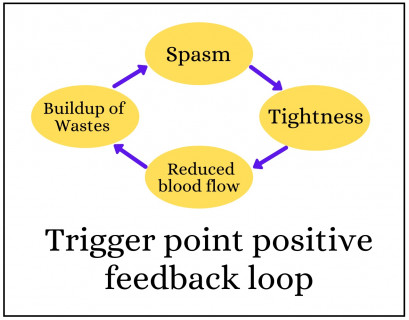
As shown in this diagram the key parts of a trigger point are muscle spasm, muscle tightness, restricted blood flow, and a build up of toxic wastes. Vibrations have been shown to help all of these. For more information please see our guide The scientifically proven effects of vibration massage- with clinical applications.
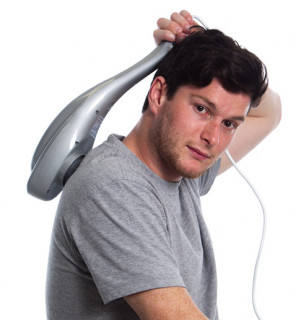
Using vibration massage is extra-ordinarily easy. We ask you to check our our instructions for the fine points and precautions, but basically all you need to do is place the vibration massager on the muscle over the trigger point and let the vibrations penetrate for 30-60 seconds. This can easily be repeated every day.
For how to choose an quality massager that will do a great job and that you will be extremely happy with please see our article How to choose a massager, or you can go straight and check out our economical, easy to use professional standard machines: the General Purpose Massager or our Ultimate Quad Head Massager.
Please continue these therapies after your pain has gone
Most people just use these therapies for pain relief, but as discussed in our article Why trigger point pain keeps coming back trigger points don’t go so the pain returns. However, if you continue using regular trigger point therapy after the pain goes it will continue to diminish the trigger points and you will be much better off than those who just do pain relief.

Typically professionals who deal with trigger points must examine and determine the problem, provide care for things other than trigger points, provide advice, and provide trigger point therapy. If you are able to do a lot of the therapy yourself this will free up your professional to spend more times doing the other things. If you don’t have a professional a good place to look would be to go to our massager order section, select your country, then select the first option: from a clinic that sells and recommend them. The website has these clinics on a map, plus listed in post code order.

If you are a professional wishing to help your patients/clients with home trigger poing therapy DrGraeme massagers were originally built by Dr Graeme for use in his clinic for this purpose and are now used by colleagues and other professionals for similar purposes. If you are a professional and wish to know more about this therapy, or possibly get a sample massager to trial please check out our practitioner page.
Below is a summary of the findings of several scientific reviews of trigger point therapies (25-31).
As said previously, the goal of trigger point therapy, according to the scientists, is to deactivate the trigger points. None mention having the goal of eliminating trigger points.
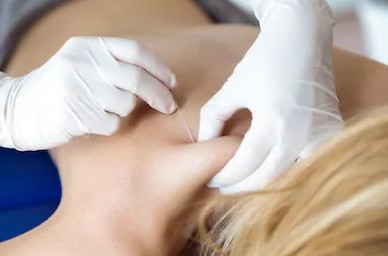
Most trials show that dry needling provides some short term pain relief and improved function. The risks and potential to cause pain are obvious. The mode of how needles work is still speculation. Where dry needling had been compared with laser the laser has given slightly better results.
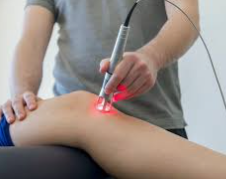
Trial results for laser have been marginally better than those for dry needling, but still only temporary relief. Scientists attribute it’s effect to increasing micro-circulation, improving oxygenation and helping remove waste products. However, this is something that can easily be achieved, if not better, by any competent massage therapist.
The big concern with laser is the sheer number of applications of therapy sessions needed for only temporary benefits. For example one trial (32) used 10 daily applications of laser on patients with upper back and neck pain to get a reduction in pain and tenderness for three weeks. Further, according to one review (33) applications of laser should be given from 2-3 times a week though to 5 times a week, with a total of 30 applications of therapy for long term cases. Keep in mind this is just to achieve deactivation, not to eliminate the problem. Assuming each laser consultation costs $50 and takes an hour out of your day that’s $1,500 and 30 hours of your life just for some temporary pain relief, leaving you to front up again next time the problem is aggravated.
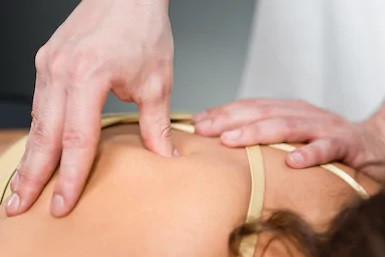
There are various types of manual therapies that involve pressure, massage and stretching of muscles. The trial results for them tend to be similar to those of laser and dry needling. However, according to one review (26) one study did show residual benefit after six months.
We are continually adding more information on research and uses. Subscribe below to have us email them to you "hot off the press".

Several years ago Dr Graeme, a Chiropractor practicing in Victoria, Australia was looking for a serious hand held massager his patients could use at home to get the extra quality massage they needed. The ones he found in the shops and on-line for home use looked nice but were not serious, and... read more
Clinical trials have shown that massage is effective in relieving fibromyalgia. However, the results show that some are better than... Read Article
Trigger points are those tender lumps in muscles that therapists find. This article covers what they are, what they do, and how they are... Read Article
Clinical trials have shown that massage is effective in relieving fibromyalgia. However, the results show that some are better than... Read Article
When we look at the root cause of fibromyalgia we need to look at two levels: 1. the malfunction of the nervous system which causes the... Read Article
As a chiropractor for over 27 years vertebral subluxation complexes are a very real problem that can cause pain, long term spinal damage... Read Article
Trigger point release is a general term that describes procedures that relax tension and relieve pain in muscles that contain trigger... Read Article
Cellulite is a very common problem which can be unsightly and have unpleasant symptoms. Common treatments include lasers, needles,... Read Article
You will find a well designed vibration massager easier to use, safer, and will do a much better job. This is because the scientific... Read Article
Massage and trigger point therapy are widely used to treat back pain. I this article we’ll discuss how these may help with your problem,... Read Article
It has been long understood that vibration massage can accelerate healing by increasing blood flow and tissue oxygenation. Until... Read Article
Do not refresh or leave this page until loading complete.